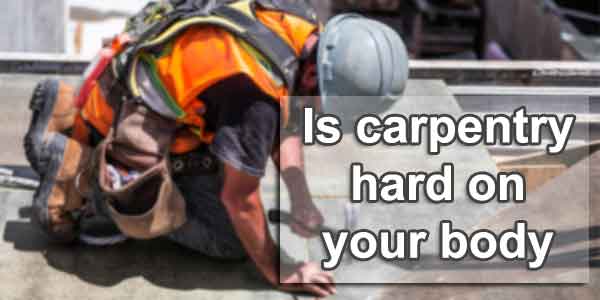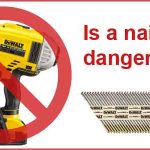Like most jobs in construction, carpentry is manual labour. It involves a lot of lifting and carrying, as well as climbing, crouching, bending, etc.
Carpenters also use a wide variety of tools for cutting and fixing timber. Many of these do have risks when not used correctly. This can include:
- Cuts and bruises
- Fragments in eyes
- Lifting injuries
- Potential for damage to hearing due to high levels of noise.
- dust which can be breathed in.
- As well as more serious injuries, such as chopping off fingers, or falling from height.

Over the years, carpentry can be hard on your body, simply due to wear and tear. This will be less noticeable when you are younger. In fact, this type of physical job will usually keep you very fit. However, over the years, complaints such as bad backs, and joint issues (particularly in the knees) are quite common.
Ensuring that you look after your general health, will help with your longevity in this type of career. Also, simple things, like using the correct lifting techniques are very important. This is especially true when it comes to looking after your back.
Carpentry and construction in general, is usually a very masculine environment, so you will often find there is pressure to move heavy objects and unload materials quickly, which can lead to over stressing your body.
Heavy weights will often mean you use bad form when lifting, which can massively increase the risk of injury. However, nobody wants to be carrying two pieces of timber, when everyone else has three or four. In this situation, you need to put ego to one side and think about the long-term consequences.
Common injuries and health problems in carpentry
As we have already mentioned, this type of work is taxing on the body, as well as carrying a relatively high risk of injury. Below we will look at some common injuries that you may encounter as a carpenter.
Small cuts
On a daily basis, small injuries like cuts and splinters, to hands and fingers are very common. These are usually things you don’t even notice, and quite often you won’t know how they happened.
These are not serious injuries and in the worst-case scenario, sticking a plaster over the cut will usually be fine.
One solution to avoid cuts, is wearing gloves where possible. However, there are many jobs in carpentry, where you need bare hands and gloves are not an option.
Bad cuts and lacerations
More serious cuts are less common, but you can easily do a lot of damage with a sharp chisel or a saw. My mentor would often tell me he wanted my chisels “finger losing sharp”. Obviously he didn’t want me to actually chop off fingers. However, sharp tools are essential to the quality of your work.
If you aren’t using sharp tools correctly or you slip, a visit to A&E is a serious possibility.
More serious amputations can, and do happen, especially with power tools such as chop saws and workshop machinery.
Hitting yourself with hammers
This is guaranteed, and over the years you will hit yourself frequently with hammers. This could be hammering a nail and hitting your finger or hammering a chisel and hitting your hands.
Blood blisters, bruises, and even fractures are not uncommon if you hit yourself hard enough.
Nail gun injuries
We already covered issues hammering nails. However, if your lucky enough to own a nail gun, you will probably do less hammering. But a nail gun does come with different risks.
Nail guns can be dangerous and shooting yourself is no joke (from personal experience), unfortunately it is quite common. The main injuries caused by nail guns are to the hands. Quite often, this is due to holding too closely, as well as not paying attention in general.
Back problems and injuries
This is a mixture of wear and tear and one-off injuries. Carpenters do a lot of lifting and carrying. This includes materials and tools. As well as lifting and holding things that are being fitted in place.
In many cases, a carpenter will be unloading tools daily. Once at the beginning of each day, and then again putting everything away at the end of a shift.
One-off lifting injuries can also happen and things like herniated disks are not uncommon. This is something I know from personal experience, as I herniated a disk whilst renovating a property.
Joint problems and injuries
This is very similar to issues with your back. They can come from general wear and tear over time. But they can also be cause by several other one-off accidents and injuries, such as lifting badly, and trips and falls.
Problems with eyes, lungs, and hearing
I have bundled these three together, as they are all prevented, or at least reduced with PPE. Building sites and carpentry work in general, can generate lots of dust and fragments that can be breathed in or lodged in your eyes.
Nasty dust, created by things like MDF and even asbestos can be encountered. So wearing a mask is essential, whenever you are creating dust.
Goggles should also be worn, in any scenario where there is risk of foreign objects getting in your eyes.
Finally, in any situations that are particularly noisy, a pair of ear defenders will protect you and reduce the risk of future hearing issues.
Conclusion
Carpentry can be hard on your body. Certainly, over time it will result in some wear and tear, and there are many risks that can cause injury. With that said, serious injury can be avoided by using the correct precautions and PPE, whilst carrying out your daily work.
Also, due to this being physical work, you are likely to be much fitter than someone sitting at a desk all day. This type of sedentary work comes with its own problems, including obesity, bad backs, poor posture, etc.
In any situation where repetitive strain is applied to your body, you are bound to have some issues over the years. However, this is true with most professions to some extent.
The key is taking all available precautions, to mitigate injury. As well as ensuring you take good care of your overall health.




